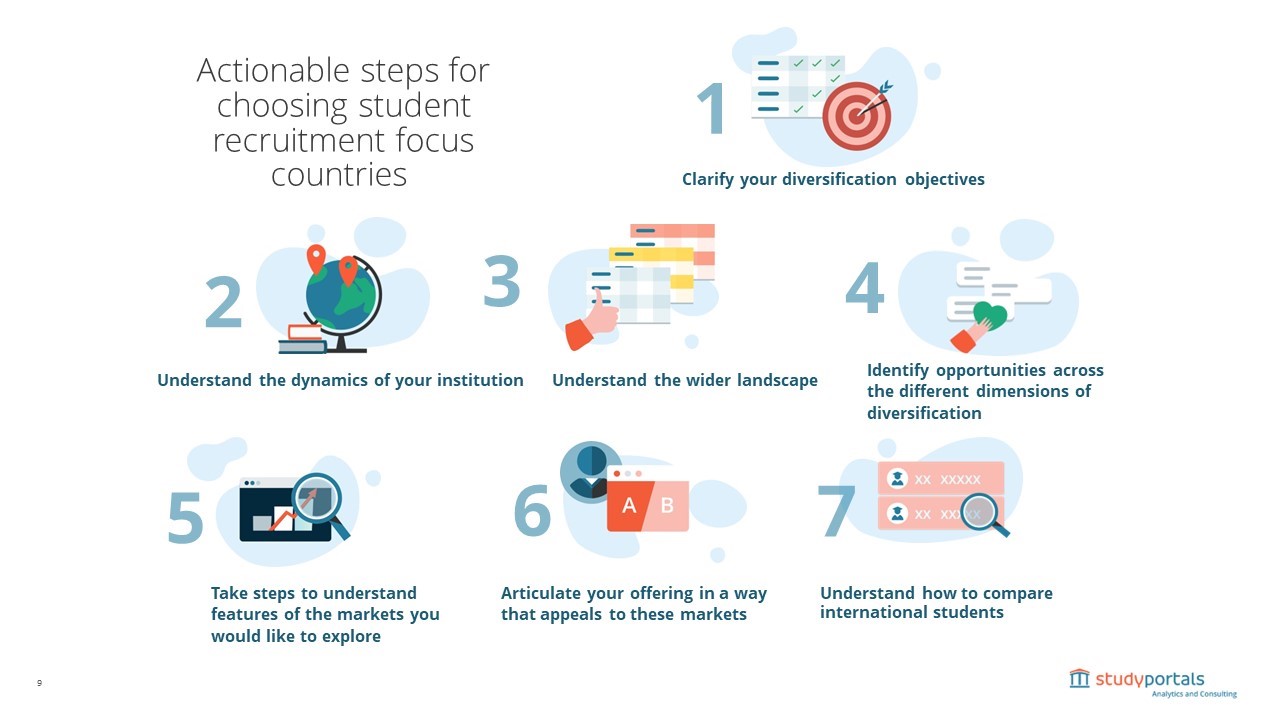Mark joined Studyportals as the Senior Partnerships Director for the UK & Ireland in July 2022 and is primarily responsible for connecting with top universities to help them diversify and grow their international student body, as well as providing them with challenging insights on international student mobility and ways to grow quality and retention of their international cohort. Mark has been working in International HE since 2011, starting at QAHE in Birmingham where he was an international officer for Africa and spent time traveling around the continent to recruit students to come and study in the UK. In 2014 he relocated to Portsmouth to look after their interests in the MENA region and then from 2017-2022 he ran the large global recruitment, marketing, and admissions teams for the University of Portsmouth, managing all pre-arrival activity for international students. He has substantial experience in both the public and private domain of the UK Higher Education sector- allowing him to understand key dynamics from multiple perspectives.
Diversity in higher education crosses several areas and dimensions- level, subject area, geography, and more.

This article will seek to discuss the benefits of obtaining, and methods needed to achieve one particular stream of diversity for institutions- geographical.
The international higher education landscape continues to change with the times: students have more options to study abroad than ever, and internationalisation has become a driving force in the growth of universities worldwide. Global student mobility for the past thirty years relied on one country – China, which has been for decades the world’s largest sending country of international students, and – more recently – a recipient.
In a shorter time span, however, the economic and demographic weight of India is also reflected in international student numbers: Indian student visas already outnumber Chinese in Canada, and for the first time, in the UK, and are growing fast in the US and Australia.
Aside from the two largest countries in the world, many other players play a significant role in international student mobility. International student mobility is one of the core axes of a more diverse classroom. International enrolments are a significant part of classroom diversity, and traditionally reflect long-term ties between countries.

While traditional recruitment grounds are still represented, developing countries drive student demand for higher education. Interest in international higher education is much higher in countries where the sector is not able to accommodate the demand for high-quality programs that can unlock global careers. The mismatch between demand and supply is at play also in destination countries, where organizations are sometimes offsetting declining demographics with an influx of global talent.
These powerful dynamics can be exploited by universities to expand their international outreach. Being dependent on just a handful of countries for their student population is a risky strategy. On top of the diversification ledger, western European countries are in a very favorable position: they are located in an interconnected network of different nationalities, with large expat communities, and in mainland Europe in particular, often offer low-tuition fee programs open to internationals.
Notably, eastern European latecomers in internationalization are less diverse and more dependent on neighbouring countries for their international student populations. They nevertheless attract a well-diversified student interest on par with other better-known destinations. These countries are well-positioned for expanding their outreach but need to establish themselves and define their brand as global study destinations.
Some destinations in the anglosphere, like Canada, Australia, and New Zealand, are close to the bottom of the list in terms of the origin of their international student populations. Despite being world-known destinations offering world-class education, these countries are overly reliant on just a handful of origin countries. The goal for a truly diverse study environment is to diversify the source countries.
Introspection
In order to attract a fully diverse cohort of entrants, an institution must itself first examine itself internally to ensure it has diverse attributes- product, academic, and marketing being key priorities for this.
Product diversification speaks to increasing the appeal of all types of programs offered by a university (with summer schools, language programs, pathways, undergraduate or post-graduate programs, on-campus, hybrid, and online adding up to the mix of programs available for international students).
Academic diversification means ensuring all departments have programs that are relevant to international students (not only relying on a few popular courses such as International Business but also on less popular subject areas with high growth potential; e.g., Studyportals’ supply and demand data shows that this is the case for Environmental Economics and Policy).
Marketing diversification is about having multiple ways to communicate with prospective students across different channels throughout the entire year: online and offline, education fairs and agents, alumni, high school counselor network, partner universities, etc., as well as a variety of online channels: education portals, various social media, search engine marketing, instant messaging, etc.
Achieving internal diversity in product, academic, and marketing tools provides strong foundations to achieve the ultimate goal- geographical diversity and the increase of source countries to create a more varied and sustainable portfolio in a broader diversification framework. Deciding on focus countries is not a one-off process- in order to take full advantage of emerging trends, institutions must be sure to be up to date with global shifts in student interest. Remember not to miss opportunities by being too focused, too early on in the process – keep options open and revisit different options over time.
Finally, by achieving diversity in the above metrics, an institution can ensure financial diversification – which will in turn spread risk across multiple markets by generating various income streams, navigating downturns, and reducing the impact of changes in any one market.
Action
For institutions – think about which cohorts of students your institution would like to increase, decrease, shift to different disciplines or diversify with more source recruitment countries. Identify the disciplines where this cohort is overrepresented and underrepresented.
Consider the current product and format mix – for example, which nationalities might be open to studying part-time or online.
Assess your marketing channels- are you covered on and off the ground with a variety of channels to ensure a healthy mix of entrants, and is your overarching message consistent across those channels? Explore new ways of reaching direct students in countries where you haven’t targeted before- with a wealth of online and digital platforms now available to institutions, no markets are off limits.

Conclusion
An effective diversification strategy must consider the diversity of students in the classroom in a more holistic way, beginning with a period of introspection. Diversification brings valuable new perspectives into the classroom to enrich the learning experience for all students. Diversity refers to all the ways in which people differ including (but not limited to) race, gender, ethnicity, religion, socioeconomic background, gender identity, sexual orientation, age, disability, and neurodiversity. These aspects of diversity also need to be considered in the context of inclusion – diversity without inclusion is pointless. A comprehensive strategy for international recruitment must also consider the ecosystem that facilitates good outcomes for international students beyond enrolment– this includes good agent networks, on-campus services, alumni relations, and student satisfaction. Ultimately, diversity starts at home- an institution must be aware of and take action to increase its own diversity in multiple formats before it can truly achieve sustained geographical diversity in its classrooms.




